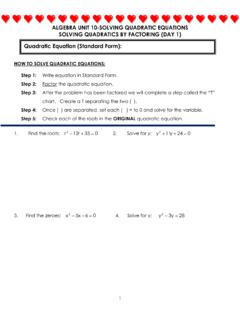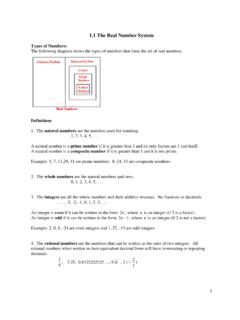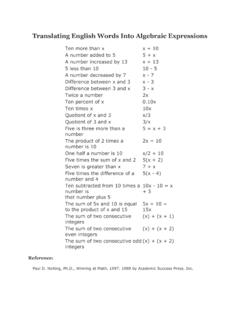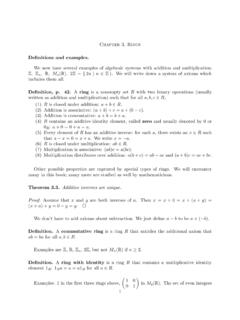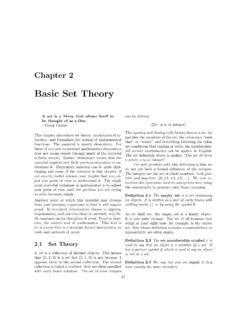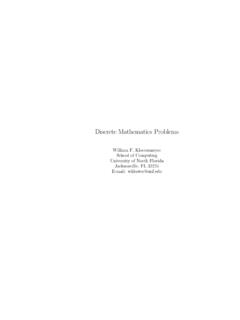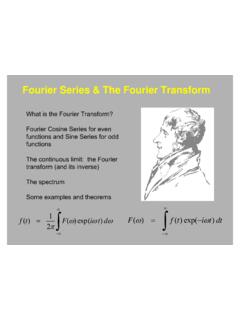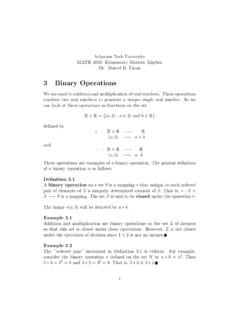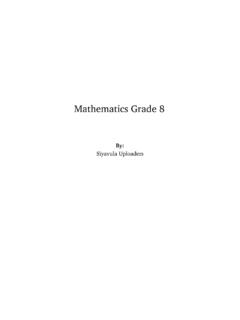Transcription of Set Theory Problems Solutions - MIT
1 JHU-CTY Theory of Computation (TCOM) Lancaster 2007 ~ Instructors Kayla Jacobs & Adam GroceSET Theory PROBLEMSSOLUTIONS * (1) Formal as a Tux and Informal as JeansDescribe the following sets in both formal and informal Set Notation DescriptionInformal English Descriptiona){2, 4, 6, 8, 10, ..}The set of all positive even integersb){.., -3, -1, 1, 3,..}The set of all odd integersc){n | n = 2m for some y }The set of all positive even integers(using the convention that 0 is not a natural number)d){x | x=2n and x=2k for some n, k }The set of all positive multiples of 6e){b | b and b=b+1} f){2, 20, 200} The set containing the numbers 2, 20, and 200g){n | n and n > 42}The set containing all integers greater than 42h){n | n and n < 42 and n > 0} = {n | n and n < 42}The set containing all positive integers less than 42i)
2 { hello } The set containing the string helloj){ bba , bab } The set containing the strings bba and babk) = {} The set containing nothing at alll){ } The set containing the empty string1 JHU-CTY Theory of Computation (TCOM) Lancaster 2007 ~ Instructors Kayla Jacobs & Adam Groce* (2) You Want Me to Write What?Fill in the blanks with , , , , =, or .Recall that is the set of all integers and is the empty set, {}.a)2_____ {2, 4, 6}b){2}_____{2, 4, 6}c) ) )15_____f)-15_____g) _____h)54_____{6, 12, 18.}
3 }i)54_____{6, 12, 18}j){1, 3, 3, 5}___=___{1, 3, 5}k){-3, 1, 5}___ ___{1, 3, 5}l){3, 1, 5}___=___{1, 3, 5}2 JHU-CTY Theory of Computation (TCOM) Lancaster 2007 ~ Instructors Kayla Jacobs & Adam Groce* (3) Set OperationsLet A = {x, y} and B = {x, y, z}.a)Is A a subset of B? YESb)Is B a subset of A? NOc)A U B = {x, y, z} = Bd)B U A = {x, y, z} = Be)A B = {x, y} = Af)B A = {x, y} = Ag)A x B = {(x, x), (x, y), (x, z), (y, x), (y, y), (y, z)}h)B x A = {(x, x), (x, y), (y, x), (y, y), (z, x), (z, y)}i)P(A) = { , {x}, {x, y}}j)P(B) = { , {x}, {y}, {z}, {x, y}, {x, z}, {y,z}, {x, y, z}}** (4) Does Order Matter?
4 Three important binary set operations are the union (U), intersection ( ), and cross product (x).A binary operation is called commutative if the order of the things it operates on doesn t example, the addition (+) operator over the integers is commutative, because for all possible integers x and y, x + y = y + , the division ( ) operator over the integers is not commutative, since x y x y for all integers x and y. (Note it works for some integers x and y, specifically whenever x = y, but not for every possible integers x and y.)
5 A)Is the union operation commutative? (Does A U B = B U A for all sets A and B?)Yes. A U B = {x | x A or x B} = {x | x B or x A} = B U A b)Is the intersection operation commutative?Yes. A B = {x | x A and x B} = {x | x B and x A} = B Ac)Is the cross product operation commutative?No. For a counterexample, see Problem (3g) and (3h) that order matters for Theory of Computation (TCOM) Lancaster 2007 ~ Instructors Kayla Jacobs & Adam Groce** (5) Set Me UpConsider the following sets:A = { }B = {A}C = {B}D = {A, }True (T) or False (F)?
6 A) A (T)b) A (T)c) B (F)d) B (T)e) C (F)f) C (T)g) D (T)h) D (T)i)A B (T)j)A B (F)k)A C (F)l)A C (F)m)A D (T)n)A D(T)o)B A (F)p)B A (F)q)B C (T)r)B C (F)s)B D (F)t)B D (T)u)C A (F)v)C A (F)w)C B (F)x)C B (F)y)C D (F)z)C D (F)Note: May be easier to think about the sets as:A = { {} } B = { {{}} } C = { {{{}}} } D = { {{}} , {} } 4










